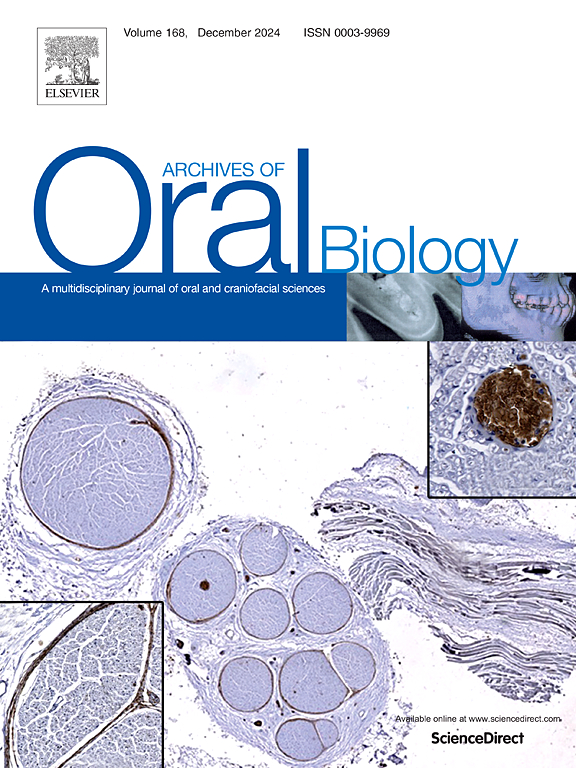Taiwanese green propolis suppresses NLRP3 inflammasome activation and induces Nrf2/HO-1 pathway to reduce periodontal pathogen-induced endothelial inflammation
IF 2.1
4区 医学
Q2 DENTISTRY, ORAL SURGERY & MEDICINE
引用次数: 0
Abstract
Objective
Periodontitis is a chronic inflammatory disease associated with systemic conditions, including cardiovascular diseases. Porphyromonas gingivalis (Pg), a key periodontal pathogen, contributes to vascular endothelial dysfunction through its virulence factors. This study aimed to investigate the protective effects of Taiwanese green propolis (TGP) against Pg-derived lipopolysaccharide (Pg-LPS)-induced endothelial inflammation, focusing on its modulation of the NLRP3 inflammasome and Nrf2/HO-1 signaling pathways.
Design
Human aortic endothelial cells (HAECs) were stimulated with Pg-LPS in the presence or absence of TGP. The expression of pro-inflammatory cytokines (IL-1β, IL-6, TNF-α) was assessed using real-time PCR and ELISA. ROS production was evaluated using fluorescence-based assays, while NF-κB activation and Nrf2 transcriptional activity were analyzed via luciferase reporter assays. Pharmacological inhibitors were used to confirm the involvement of these pathways.
Results
TGP significantly reduced Pg-LPS-induced IL-1β, TNF-α, and IL-6 expression in HAECs. It inhibited NF-κB activation, suppressed ROS generation, and attenuated NLRP3 inflammasome activation. Additionally, TGP upregulated HO-1 expression and enhanced Nrf2 transcriptional activity, as evidenced by ARE-driven luciferase reporter assays. Pharmacological inhibition of Nrf2 and HO-1 reversed TGP’s anti-inflammatory effects, confirming that the Nrf2/HO-1 axis is critical for its protective function.
Conclusions
These findings demonstrate that TGP exerts anti-inflammatory and cytoprotective effects by suppressing NLRP3 inflammasome activation and enhancing the Nrf2/HO-1 pathway, reducing Pg-LPS-induced endothelial inflammation. This study suggests that TGP could be a promising natural therapeutic agent for mitigating periodontal pathogen-induced systemic inflammation.
台湾绿蜂胶抑制NLRP3炎性体激活,诱导Nrf2/HO-1通路,减少牙周病原体诱导的内皮炎症
目的牙周炎是一种与全身疾病相关的慢性炎症性疾病,包括心血管疾病。牙龈卟啉单胞菌(Porphyromonas gingivalis, Pg)是一种重要的牙周病原体,通过其毒力因子导致血管内皮功能障碍。本研究旨在探讨台湾绿蜂胶(TGP)对Pg-derived脂多糖(Pg-LPS)诱导的内皮细胞炎症的保护作用,重点研究其对NLRP3炎性体和Nrf2/HO-1信号通路的调节作用。在存在或不存在TGP的情况下,用Pg-LPS刺激人主动脉内皮细胞(HAECs)。采用real-time PCR和ELISA检测促炎因子(IL-1β、IL-6、TNF-α)的表达。采用荧光法评估ROS生成,采用荧光素酶报告基因法分析NF-κB激活和Nrf2转录活性。药理抑制剂被用来证实这些途径的参与。结果stgp显著降低了pg - lps诱导的haec中IL-1β、TNF-α和IL-6的表达。抑制NF-κB活化,抑制ROS生成,减弱NLRP3炎性体活化。此外,TGP上调HO-1的表达,增强Nrf2的转录活性,这一点得到了驱动荧光素酶报告基因检测的证实。Nrf2和HO-1的药理抑制逆转了TGP的抗炎作用,证实Nrf2/HO-1轴对其保护功能至关重要。结论TGP通过抑制NLRP3炎性小体激活,增强Nrf2/HO-1通路,减轻pg - lps诱导的内皮细胞炎症,发挥抗炎和细胞保护作用。本研究提示TGP可能是一种很有前景的天然治疗药物,可以减轻牙周病原体引起的全身炎症。
本文章由计算机程序翻译,如有差异,请以英文原文为准。
求助全文
约1分钟内获得全文
求助全文
来源期刊

Archives of oral biology
医学-牙科与口腔外科
CiteScore
5.10
自引率
3.30%
发文量
177
审稿时长
26 days
期刊介绍:
Archives of Oral Biology is an international journal which aims to publish papers of the highest scientific quality in the oral and craniofacial sciences. The journal is particularly interested in research which advances knowledge in the mechanisms of craniofacial development and disease, including:
Cell and molecular biology
Molecular genetics
Immunology
Pathogenesis
Cellular microbiology
Embryology
Syndromology
Forensic dentistry
 求助内容:
求助内容: 应助结果提醒方式:
应助结果提醒方式:


